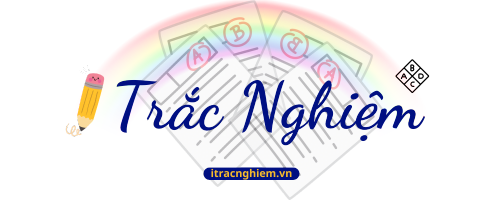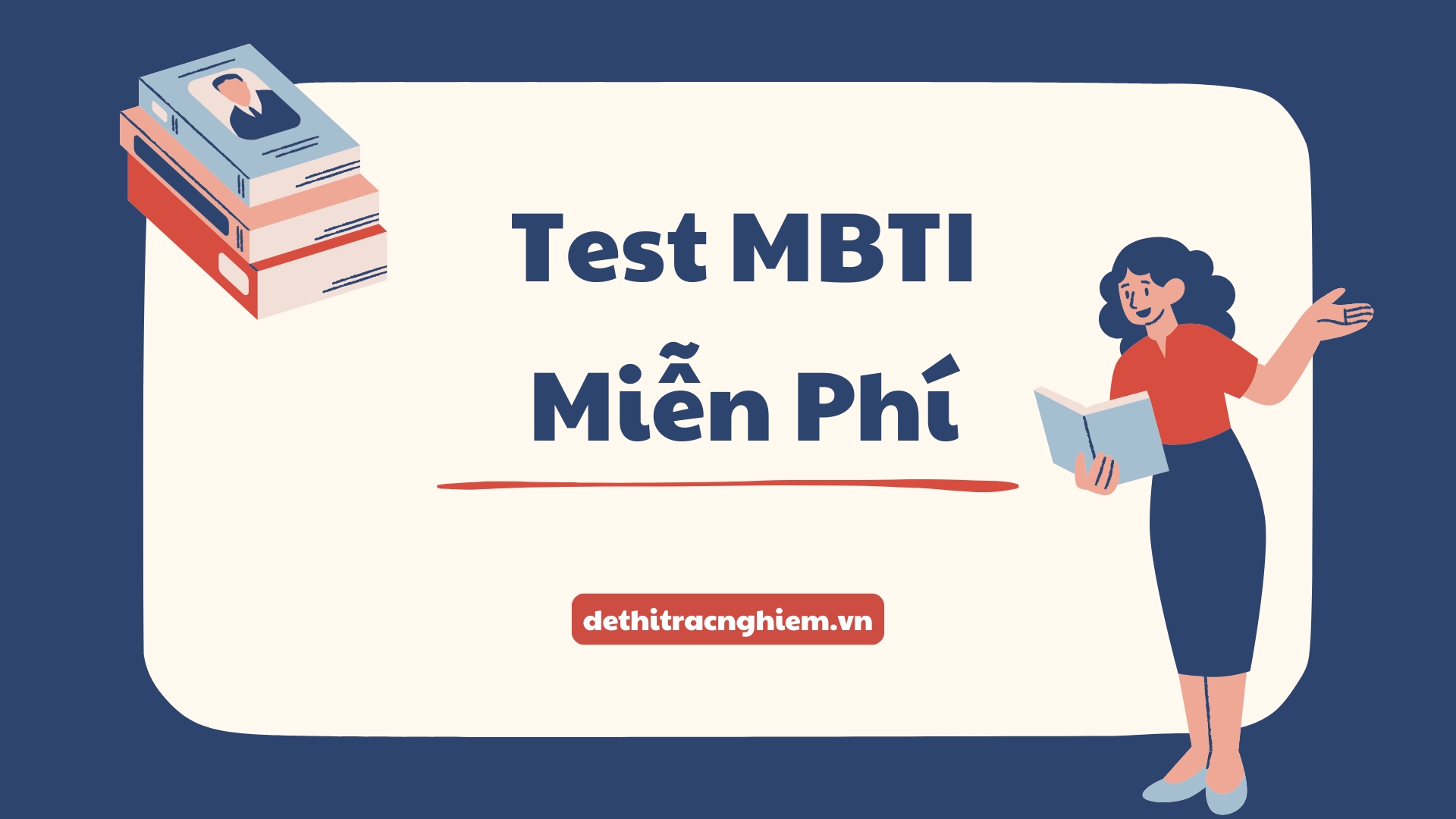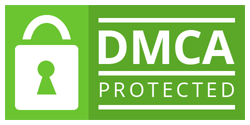Đề thi thử Đại học 2025 môn Tiếng Anh – THCS&THPT Nguyễn Khuyến – Bình Dương là một trong những đề tiêu biểu thuộc Tổng hợp đề thi thử môn Tiếng Anh THPT QG, nằm trong chương trình Đề thi vào Đại học. Đây là đề thi thử được xây dựng bởi Trường THCS&THPT Nguyễn Khuyến – một trong những đơn vị giáo dục có chất lượng đào tạo nổi bật tại tỉnh Bình Dương, với mục tiêu giúp học sinh lớp 12 luyện tập kỹ năng và củng cố kiến thức trước kỳ thi tốt nghiệp THPT năm 2025.
Đề thi được thiết kế sát với cấu trúc chuẩn của Bộ GD&ĐT, bao gồm các phần: phát âm – trọng âm, từ vựng – ngữ pháp, chức năng giao tiếp, tìm lỗi sai, đọc điền từ, đọc hiểu và viết lại câu. Trọng tâm kiến thức tập trung vào chương trình lớp 12, bao gồm các chủ điểm như: câu điều kiện, mệnh đề quan hệ, thì của động từ, câu bị động, đảo ngữ, collocations, idioms và cấu trúc viết lại câu. Phần đọc hiểu có tính phân hóa tốt, giúp học sinh nâng cao kỹ năng đọc nhanh – hiểu sâu và chuẩn bị tốt cho bài thi thực tế.
Hãy cùng Dethitracnghiem.vn tìm hiểu về đề thi này và tham gia làm kiểm tra ngay lập tức!
- Số trang: 4 trang
- Hình thức: Trắc nghiệm
- Thời gian làm bài: 50 phút (không kể thời gian phát đề)
ĐỀ THI THỬ ĐẠI HỌC MÔN TIẾNG ANH NĂM 2025 THCS&THPT NGUYỄN KHUYẾN – BÌNH DƯƠNG
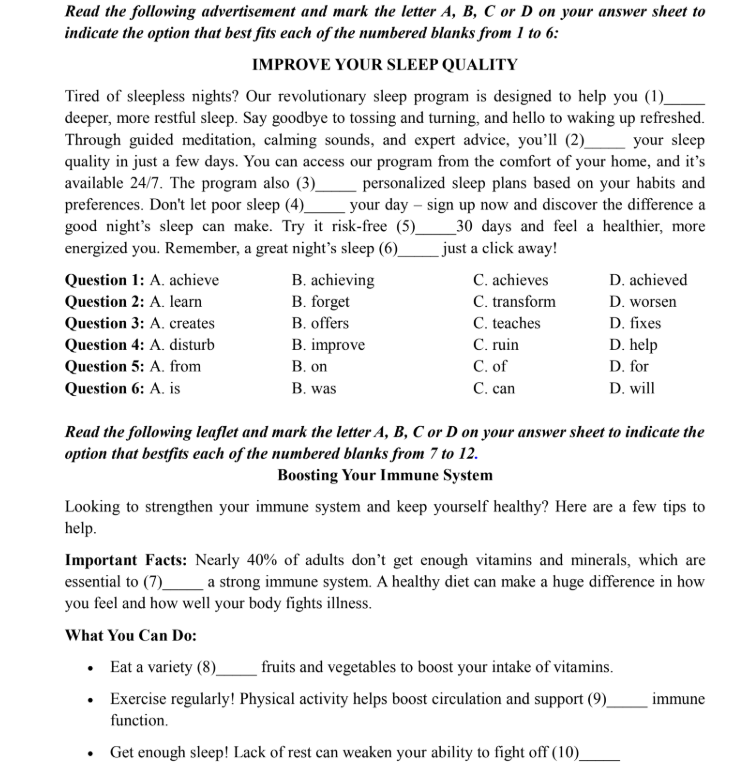
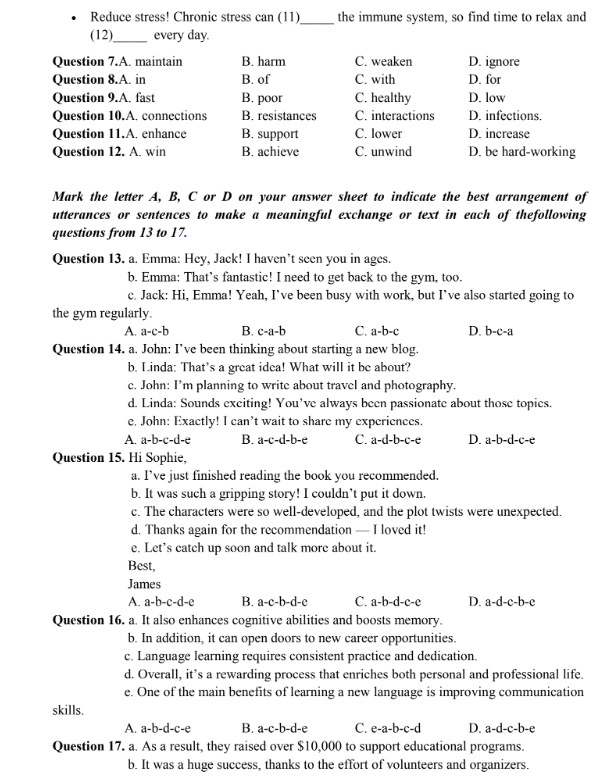
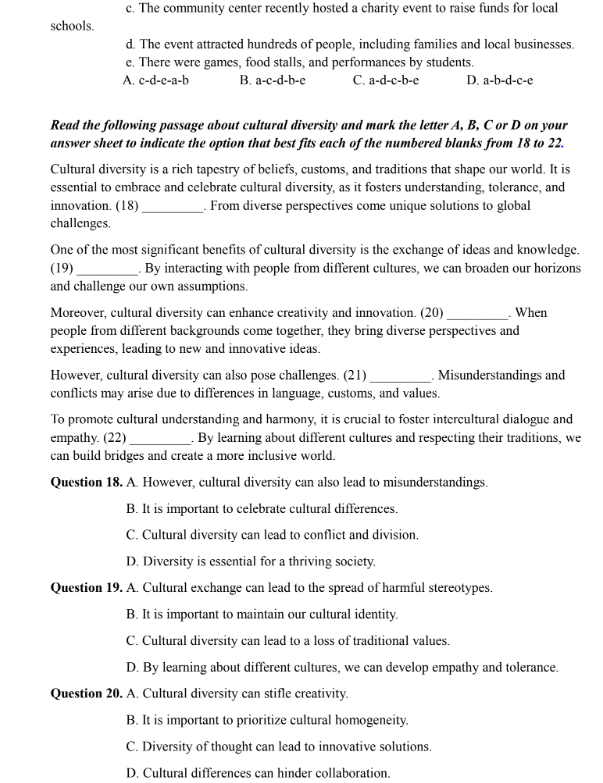
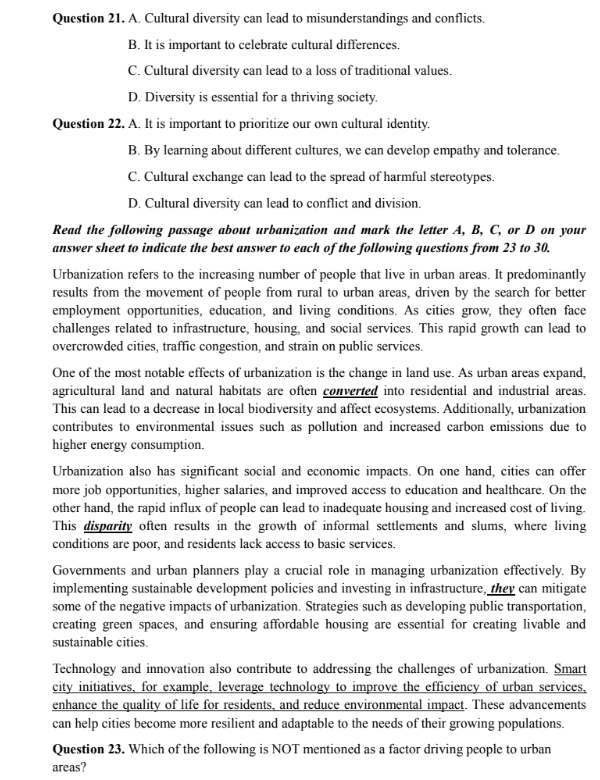
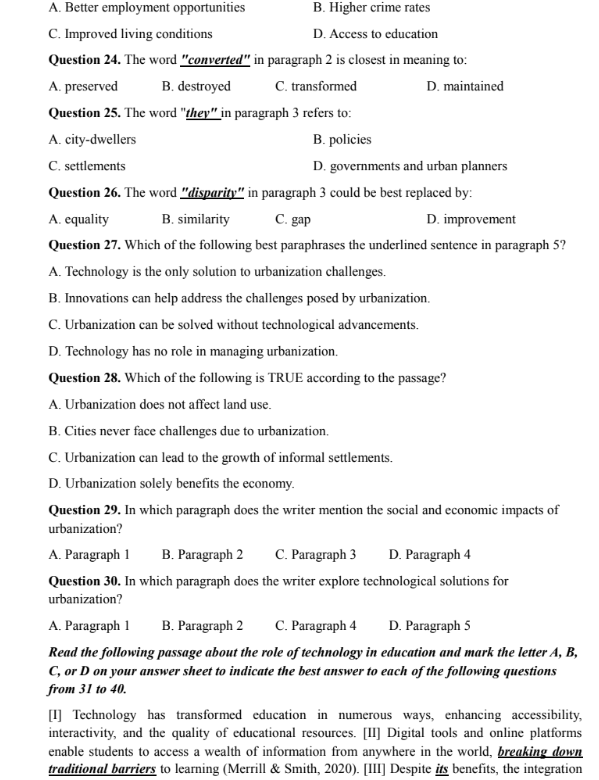
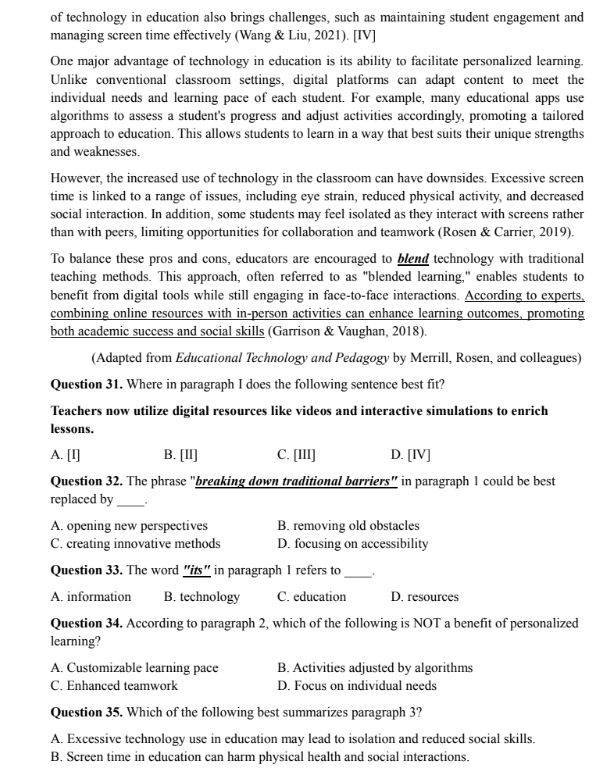
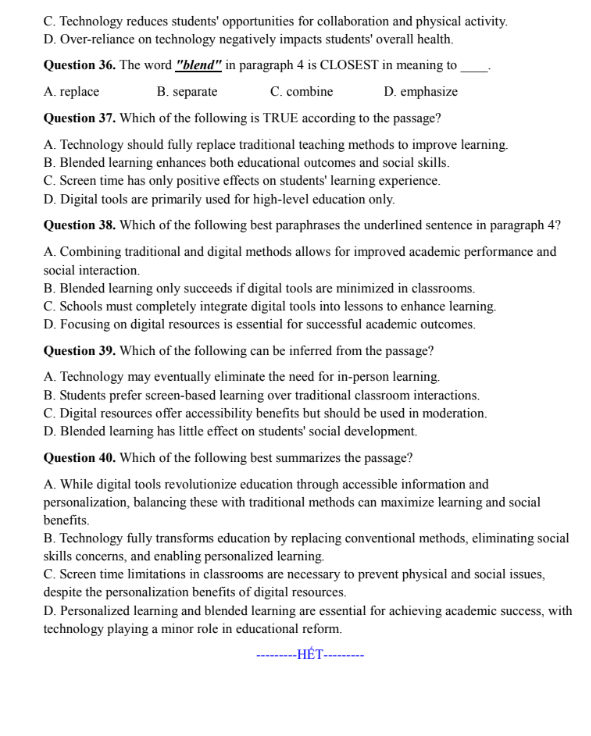
Read the following advertisement and mark the letter A, B, C or D on your answer sheet to indicate the option that best fits each of the numbered blanks from 1 to 6:
IMPROVE YOUR SLEEP QUALITY
Tired of sleepless nights? Our revolutionary sleep program is designed to help you (1) _______ deeper, more restful sleep. Say goodbye to tossing and turning, and hello to waking up refreshed. Through guided meditation, calming sounds, and expert advice, you’ll (2) _______ your sleep quality in just a few days. You can access our program from the comfort of your home, and it’s available 24/7. The program also (3) _______ personalized sleep plans based on your habits and preferences. Don’t let poor sleep (4) _______ your day – sign up now and discover the difference a good night’s sleep can make. Try it risk-free (5) _______ 30 days and feel a healthier, more energized you. Remember, a great night’s sleep (6) _______ just a click away!
Question 1:
A. achieve
B. achieving
C. achieves
D. achieved
Question 2:
A. learn
B. forget
C. transform
D. worsen
Question 3:
A. creates
B. offers
C. teaches
D. fixes
Question 4:
A. disturb
B. improve
C. ruin
D. help
Question 5:
A. from
B. on
C. of
D. for
Question 6:
A. is
B. was
C. can
D. will
Read the following leaflet and mark the letter A, B, C or D on your answer sheet to indicate the option that bestfits each of the numbered blanks from 7 to 12.
Boosting Your Immune System
Looking to strengthen your immune system and keep yourself healthy? Here are a few tips to help.
Important Facts: Nearly 40% of adults don’t get enough vitamins and minerals, which are essential to (7) _______ a strong immune system. A healthy diet can make a huge difference in how you feel and how well your body fights illness.
What You Can Do:
Eat a variety (8) _______ fruits and vegetables to boost your intake of vitamins.
Exercise regularly! Physical activity helps boost circulation and support (9) _______ immune function.
Get enough sleep! Lack of rest can weaken your ability to fight off (10) _______.
Reduce stress! Chronic stress can (11) _______ the immune system, so find time to relax and (12) _______ every day.
Question 7:
A. maintain
B. harm
C. weaken
D. ignore
Question 8:
A. in
B. of
C. with
D. for
Question 9:
A. fast
B. poor
C. healthy
D. low
Question 10:
A. connections
B. resistances
C. interactions
D. infections
Question 11:
A. enhance
B. support
C. lower
D. increase
Question 12:
A. win
B. achieve
C. unwind
D. be hard-working
Mark the letter A, B, C or D on your answer sheet to indicate the best arrangement of utterances or sentences to make a meaningful exchange or text in each of thefollowing questions from 13 to 17.
Question 13:
a. Emma: Hey, Jack! I haven’t seen you in ages.
b. Emma: That’s fantastic! I need to get back to the gym, too.
c. Jack: Hi, Emma! Yeah, I’ve been busy with work, but I’ve also started going to the gym regularly.
A. a-c-b
B. c-a-b
C. a-b-c
D. b-c-a
Question 14:
a. John: I’ve been thinking about starting a new blog.
b. Linda: That’s a great idea! What will it be about?
c. John: I’m planning to write about travel and photography.
d. Linda: Sounds exciting! You’ve always been passionate about those topics.
e. John: Exactly! I can’t wait to share my experiences.
A. a-b-c-d-e
B. a-c-d-b-e
C. a-d-b-c-e
D. a-b-d-c-e
Question 15:
Hi Sophie,
a. I’ve just finished reading the book you recommended.
b. It was such a gripping story! I couldn’t put it down.
c. The characters were so well-developed, and the plot twists were unexpected.
d. Thanks again for the recommendation — I loved it!
e. Let’s catch up soon and talk more about it.
Best,
James
A. a-b-c-d-e
B. a-c-b-d-e
C. a-b-d-c-e
D. a-d-c-b-e
Question 16:
a. It also enhances cognitive abilities and boosts memory.
b. In addition, it can open doors to new career opportunities.
c. Language learning requires consistent practice and dedication.
d. Overall, it’s a rewarding process that enriches both personal and professional life.
e. One of the main benefits of learning a new language is improving communication skills.
A. a-b-d-c-e
B. a-c-b-d-e
C. e-a-b-c-d
D. a-d-c-b-e
Question 17:
a. As a result, they raised over $10,000 to support educational programs.
b. It was a huge success, thanks to the effort of volunteers and organizers.
c. The community center recently hosted a charity event to raise funds for local schools.
d. The event attracted hundreds of people, including families and local businesses.
e. There were games, food stalls, and performances by students.
A. c-d-e-a-b
B. c-d-e-b-a
C. a-d-c-b-e
D. a-b-d-c-e
Read the following passage about cultural diversity and mark the letter A, B, C or D on your answer sheet to indicate the option that best fits each of the numbered blanks from 18 to 22.
Cultural diversity is a rich tapestry of beliefs, customs, and traditions that shape our world. It is essential to embrace and celebrate cultural diversity, as it fosters understanding, tolerance, and innovation. (18) _______. From diverse perspectives come unique solutions to global challenges.
One of the most significant benefits of cultural diversity is the exchange of ideas and knowledge. (19) _______. By interacting with people from different cultures, we can broaden our horizons and challenge our own assumptions.
Moreover, cultural diversity can enhance creativity and innovation. (20) _______. When people from different backgrounds come together, they bring diverse perspectives and experiences, leading to new and innovative ideas.
However, cultural diversity can also pose challenges. (21) _______. Misunderstandings and conflicts may arise due to differences in language, customs, and values.
To promote cultural understanding and harmony, it is crucial to foster intercultural dialogue and empathy. (22) _______. By learning about different cultures and respecting their traditions, we can build bridges and create a more inclusive world.
Question 18:
A. However, cultural diversity can also lead to misunderstandings.
B. It is important to celebrate cultural differences.
C. Cultural diversity can lead to conflict and division.
D. Diversity is essential for a thriving society.
Question 19:
A. Cultural exchange can lead to the spread of harmful stereotypes.
B. It is important to maintain our cultural identity.
C. Cultural diversity can lead to a loss of traditional values.
D. By learning about different cultures, we can develop empathy and tolerance.
Question 20:
A. Cultural diversity can stifle creativity.
B. It is important to prioritize cultural homogeneity.
C. Diversity of thought can lead to innovative solutions.
D. Cultural differences can hinder collaboration.
Question 21:
A. Cultural diversity can lead to misunderstandings and conflicts.
B. It is important to celebrate cultural differences.
C. Cultural diversity can lead to a loss of traditional values.
D. Diversity is essential for a thriving society.
Question 22:
A. It is important to prioritize our own cultural identity.
B. By learning about different cultures, we can develop empathy and tolerance.
C. Cultural exchange can lead to the spread of harmful stereotypes.
D. Cultural diversity can lead to conflict and division.
Read the following passage about urbanization and mark the letter A, B, C, or D on your answer sheet to indicate the best answer to each of the following questions from 23 to 30.
Urbanization refers to the increasing number of people that live in urban areas. It predominantly results from the movement of people from rural to urban areas, driven by the search for better employment opportunities, education, and living conditions. As cities grow, they often face challenges related to infrastructure, housing, and social services. This rapid growth can lead to overcrowded cities, traffic congestion, and strain on public services.
One of the most notable effects of urbanization is the change in land use. As urban areas expand, agricultural land and natural habitats are often converted into residential and industrial areas. This can lead to a decrease in local biodiversity and affect ecosystems. Additionally, urbanization contributes to environmental issues such as pollution and increased carbon emissions due to higher energy consumption.
Urbanization also has significant social and economic impacts. On one hand, cities can offer more job opportunities, higher salaries, and improved access to education and healthcare. On the other hand, the rapid influx of people can lead to inadequate housing and increased cost of living. This disparity often results in the growth of informal settlements and slums, where living conditions are poor, and residents lack access to basic services.
Governments and urban planners play a crucial role in managing urbanization effectively. By implementing sustainable development policies and investing in infrastructure, they can mitigate some of the negative impacts of urbanization. Strategies such as developing public transportation, creating green spaces, and ensuring affordable housing are essential for creating livable and sustainable cities.
Technology and innovation also contribute to addressing the challenges of urbanization. Smart city initiatives, for example, leverage technology to improve the efficiency of urban services, enhance the quality of life for residents, and reduce environmental impact. These advancements can help cities become more resilient and adaptable to the needs of their growing populations.
Question 23: Which of the following is NOT mentioned as a factor driving people to urban areas?
A. Better employment opportunities
B. Higher crime rates
C. Improved living conditions
D. Access to education
Question 24: The word “converted” in paragraph 2 is closest in meaning to:
A. preserved
B. destroyed
C. transformed
D. maintained
Question 25: The word “they” in paragraph 3 refers to:
A. city-dwellers
B. policies
C. settlements
D. governments and urban planners
Question 26: The word “disparity” in paragraph 3 could be best replaced by:
A. equality
B. similarity
C. gap
D. improvement
Question 27: Which of the following best paraphrases the underlined sentence in paragraph 5?
A. Technology is the only solution to urbanization challenges.
B. Innovations can help address the challenges posed by urbanization.
C. Urbanization can be solved without technological advancements.
D. Technology has no role in managing urbanization.
Question 28: Which of the following is TRUE according to the passage?
A. Urbanization does not affect land use.
B. Cities never face challenges due to urbanization.
C. Urbanization can lead to the growth of informal settlements.
D. Urbanization solely benefits the economy.
Question 29: In which paragraph does the writer mention the social and economic impacts of urbanization?
A. Paragraph 1
B. Paragraph 2
C. Paragraph 3
D. Paragraph 4
Question 30: In which paragraph does the writer explore technological solutions for urbanization?
A. Paragraph 1
B. Paragraph 2
C. Paragraph 4
D. Paragraph 5
Read the following passage about the role of technology in education and mark the letter A, B, C, or D on your answer sheet to indicate the best answer to each of the following questions from 31 to 40.
[I] Technology has transformed education in numerous ways, enhancing accessibility, interactivity, and the quality of educational resources. [II] Digital tools and online platforms enable students to access a wealth of information from anywhere in the world, breaking down traditional barriers to learning (Merrill & Smith, 2020). [III] Despite its benefits, the integration of technology in education also brings challenges, such as maintaining student engagement and managing screen time effectively (Wang & Liu, 2021). [IV]
One major advantage of technology in education is its ability to facilitate personalized learning. Unlike conventional classroom settings, digital platforms can adapt content to meet the individual needs and learning pace of each student. For example, many educational apps use algorithms to assess a student’s progress and adjust activities accordingly, promoting a tailored approach to education. This allows students to learn in a way that best suits their unique strengths and weaknesses.
However, the increased use of technology in the classroom can have downsides. Excessive screen time is linked to a range of issues, including eye strain, reduced physical activity, and decreased social interaction. In addition, some students may feel isolated as they interact with screens rather than with peers, limiting opportunities for collaboration and teamwork (Rosen & Carrier, 2019).
To balance these pros and cons, educators are encouraged to blend technology with traditional teaching methods. This approach, often referred to as “blended learning,” enables students to benefit from digital tools while still engaging in face-to-face interactions. According to experts, combining online resources with in-person activities can enhance learning outcomes, promoting both academic success and social skills (Garrison & Vaughan, 2018).
Question 31: Where in paragraph 1 does the following sentence best fit?
“Teachers now utilize digital resources like videos and interactive simulations to enrich lessons.”
A. [I]
B. [II]
C. [III]
D. [IV]
Question 32: The phrase “breaking down traditional barriers” in paragraph 1 could be best replaced by _______.
A. opening new perspectives
B. removing old obstacles
C. creating innovative methods
D. focusing on accessibility
Question 33: The word “its” in paragraph 1 refers to _______.
A. information
B. technology
C. education
D. resources
Question 34: According to paragraph 2, which of the following is NOT a benefit of personalized learning?
A. Customizable learning pace
B. Activities adjusted by algorithms
C. Enhanced teamwork
D. Focus on individual needs
Question 35: Which of the following best summarizes paragraph 3?
A. Excessive technology use in education may lead to isolation and reduced social skills.
B. Screen time in education can harm physical health and social interactions.
C. Technology reduces students’ opportunities for collaboration and physical activity.
D. Over-reliance on technology negatively impacts students’ overall health.
Question 36: The word “blend” in paragraph 4 is CLOSEST in meaning to _______.
A. replace
B. separate
C. combine
D. emphasize
Question 37: Which of the following is TRUE according to the passage?
A. Technology should fully replace traditional teaching methods to improve learning.
B. Blended learning enhances both educational outcomes and social skills.
C. Screen time has only positive effects on students’ learning experience.
D. Digital tools are primarily used for high-level education only.
Question 38: Which of the following best paraphrases the underlined sentence in paragraph 4?
A. Combining traditional and digital methods allows for improved academic performance and social interaction.
B. Blended learning only succeeds if digital tools are minimized in classrooms.
C. Schools must completely integrate digital tools into lessons to enhance learning.
D. Focusing on digital resources is essential for successful academic outcomes.
Question 39: Which of the following can be inferred from the passage?
A. Technology may eventually eliminate the need for in-person learning.
B. Students prefer screen-based learning over traditional classroom interactions.
C. Digital resources offer accessibility benefits but should be used in moderation.
D. Blended learning has little effect on students’ social development.
Question 40: Which of the following best summarizes the passage?
A. While digital tools revolutionize education through accessible information and personalization, balancing these with traditional methods can maximize learning and social benefits.
B. Technology fully transforms education by replacing conventional methods, eliminating social skills concerns, and enabling personalized learning.
C. Screen time limitations in classrooms are necessary to prevent physical and social issues, despite the personalization benefits of digital resources.
D. Personalized learning and blended learning are essential for achieving academic success, with technology playing a minor role in educational reform.
Mục đích tổ chức kỳ thi Đại học năm 2025 là gì?
Căn cứ theo quy chế hiện hành của Bộ Giáo dục và Đào tạo và các văn bản hướng dẫn tổ chức kỳ thi Đại học năm 2025, mục đích của kỳ thi là:
– Đánh giá kết quả học tập của học sinh sau 12 năm học theo yêu cầu của chương trình giáo dục phổ thông.
– Lấy kết quả thi để xét công nhận tốt nghiệp trung học phổ thông và làm căn cứ tuyển sinh đại học, cao đẳng.
– Góp phần đánh giá chất lượng giáo dục của địa phương và cả nước, làm cơ sở điều chỉnh nội dung, phương pháp dạy học trong nhà trường.
Thí sinh thi Đại học năm 2025 có bắt buộc thi môn Tiếng Anh không?
Theo quy định hiện hành của Bộ Giáo dục và Đào tạo và hướng dẫn tổ chức kỳ thi tốt nghiệp Đại học năm 2025, thí sinh dự thi phải thực hiện như sau:
– Thi 3 môn bắt buộc: Toán, Ngữ văn và Ngoại ngữ.
– Ngoài ra, thí sinh phải chọn một trong hai bài thi tổ hợp: Khoa học Tự nhiên (gồm các môn Vật lí, Hóa học, Sinh học) hoặc Khoa học Xã hội (gồm các môn Lịch sử, Địa lí, Giáo dục công dân – dành cho học sinh học chương trình giáo dục phổ thông).
Trong số các môn thi, Tiếng Anh là một trong ba môn thuộc bài thi Ngoại ngữ bắt buộc, thí sinh phải thi môn Tiếng Anh như một môn bắt buộc, không phụ thuộc vào lựa chọn bài thi tổ hợp hay mục đích xét tuyển đại học.
Như vậy, kỳ thi Đại học năm 2025 bắt buộc thí sinh phải thi môn Tiếng Anh.
